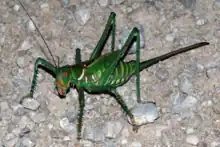| Neobarrettia spinosa | |
|---|---|
 | |
| Scientific classification | |
| Domain: | Eukaryota |
| Kingdom: | Animalia |
| Phylum: | Arthropoda |
| Class: | Insecta |
| Order: | Orthoptera |
| Suborder: | Ensifera |
| Family: | Tettigoniidae |
| Genus: | Neobarrettia |
| Species: | N. spinosa |
| Binomial name | |
| Neobarrettia spinosa (Caudell, 1907) | |
| Synonyms | |
| |
Neobarrettia spinosa, also known as the greater arid-land katydid, red eyed katydid (or red eyed devil), or giant Texas katydid, is a species of katydid native to the southwestern United States and northern Mexico.[1]
Habitat
Neobarrettia spinosa inhabits oak-juniper woodlands and arid-land deserts with mesquites or other brushes.
Biology
Neobarrettia spinosa is a carnivorous insect. It stalks through the underbrush and consumes grasshoppers, other katydids, caterpillars, small frogs, lizards, and any other small animal it can overpower. It is a known predator of the endangered songbird, Vireo atricapilla.[2] These animals present a threat posture when under attack, and will defend with a powerful bite and strong kick.
References
- ↑ "species Neobarrettia spinosa (Caudell, 1907): Orthoptera Species File". orthoptera.speciesfile.org. Retrieved 2016-07-10.
- ↑ Smith, Kathryn; Cain III, James; Morrison, Michael; Wilkins, R. Neal (2012). "A Novel Songbird Nest Predator: The Greater Arid-Land Katydid". The American Midland Naturalist. 167 (1): 210–212. Retrieved 2021-07-27.
External links
This article is issued from Wikipedia. The text is licensed under Creative Commons - Attribution - Sharealike. Additional terms may apply for the media files.